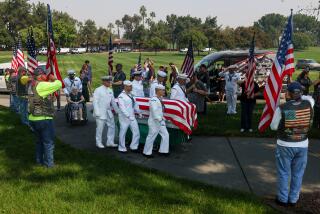Commanding Carrier: Just One Mistake Can Torpedo a Navy Career
- Share via
SAN DIEGO — They are the chosen few--14 of the Navy’s most daring and highly decorated war heroes, who each day play judge, jury, jailer, father figure, fire chief, treasurer and mayor aboard a floating city of 6,000.
Few jobs in America can match the power and prestige of a commanding officer of an aircraft carrier, the largest ships in the Navy. But along with the authority comes the peril that a freak accident such as a fire or an oil spill could end an illustrious military career. Seven commanding officers have been disciplined during the past 3 1/2 years for carrier mishaps, ranging from collisions at sea to the death of a sailor in the brig.
These cases include Capt. Phillip R. Wood, who relinquished command of the Kitty Hawk in San Diego last week. Wood was admonished with an “administrative letter of caution” in October for his role in improper supply purchases. He will retire March 31 after 31 years of service.
Capt. Robert Leuschner was replaced Jan. 27 as skipper of the Enterprise after the ship struck a rock 100 miles west of San Diego in November, causing $17 million in damage to the hull.
Collided With Tanker
The Navy is also investigating the possible grounding of the Coral Sea in the Eastern Mediterranean in December, which caused the ship’s water condensers to ingest large amounts of sand. A Navy spokesman said the ship’s commanding officer, Capt. Robert Ferguson, is not likely to be disciplined. Ferguson took control of the Coral Sea from Capt. Gene Tucker, who was removed as commanding officer in May after the carrier collided with an Ecuadorean oil tanker.
The recent string of disciplinary cases has led a number of top Navy officers to reconsider their career goals of commanding an aircraft carrier. Recently, several senior officers have declined commanding officer jobs in favor of bureaucratic jobs in the Pentagon, Navy sources said.
Working in Washington is “a hell of a lot safer than being commander on a carrier,” said Eugene J. Carroll Jr., a retired Navy admiral who is deputy director of the Center for Defense Information in Washington. “You’re not at the mercy of some seaman or fireman in an aft boiler room turning the wrong valve . . . or a storekeeper who fiddles with the computer.”
In a related development, the Navy last year began selecting management personnel for promotion to admiral, without making them compete with veteran combat officers.
“Now, pursuing a career in procurement . . . provides a path to promotion all the way to four stars that is as attractive as (sea duty),” Navy Secretary John Lehman Jr. told the House Armed Services Committee this month.
Promotions Schedule
Carroll warned that since the new promotions schedule for its management personnel in Washington was introduced last year, the Navy is beginning to lose some of its highly qualified leaders at sea to desk jobs.
Nonetheless, most Navy captains continue to strive for command positions on aircraft carriers. For example, Capt. David Hoffman, who succeeded Wood last week, said he did not hesitate to accept the opportunity to become commanding officer of the Kitty Hawk.
“This is what I’ve wanted to do since 1958, when I went into the Naval Academy,” said Hoffman, a decorated Navy fighter pilot who flew 200 combat missions over North Vietnam and was a prisoner of war for 15 months. “I recognize the risks. . . . I’m far more interested in going ahead and taking the challenge and seeing if I can meet up with it.”
Wood said that when a captain has trouble like the supply department problems that preceded his departure, other captains sympathize.
“But that’s the way it is. He didn’t do something right. Maybe he could have avoided that, you know,” he said.
In addition to Leuschner, Wood and Tucker, four other commanding officers of carriers have been formally disciplined by the Navy since 1982:
- Capt. Dan Pederson retired after he received his second letter of censure in October, 1982, for the reported abuse of prisoners in the brig aboard the Ranger.
- Capt. Robert E. Taylor received a reprimand and was not promoted to admiral after the Kitty Hawk collided with the Canadian destroyer Yukon off the Washington coast in January, 1983.
- In a particularly embarrassing episode in April, 1983, thousands of cheering relatives were waiting to greet the crew of the nuclear-powered Enterprise on its return home from an eight-month cruise when the carrier ran aground in San Francisco Bay.
Navy officials immediately announced that they were conducting an inquiry into the grounding that could have “catastrophic career implications” for the ship’s commander, Capt. Robert J. Kelly.
Kelly accepted full responsibility for the grounding and was reprimanded. However the incident apparently did not jeopardize his career. Although the Navy probe concluded that “human error” caused the accident, Kelly was promoted two months later to commodore and is now a rear admiral.
- Capt. Arthur Frederickson was reprimanded after the Ranger hit the fleet tanker Wichita in July, 1983--only a week after he relieved Capt. Anthony Less. The collision caused nearly $1 million in damage to both ships.
Four months later, Frederickson was in trouble again after a fire broke out in one of the Ranger’s machinery rooms, killing six sailors. Frederickson quit the Navy last July.
Wood’s supply department problems have sparked a renewed interest among commanding officers to focus special attention on all operations aboard carriers, from the quality of the four tons of meat and vegetables served daily to the spare parts inventory of 100,000 line items valued at more than $200 million.
Critical Operations
Some carrier commanders make the mistake of spending nearly all of their time on the bridge, the place where navigators maneuver the ship and air officers oversee the movement of 90 aircraft on the crowded deck, Carroll said. In doing so, they neglect other critical operations on the 16 decks below the bridge.
Crucial responsibilities aboard a carrier include handling 20,000 tons of conventional weapons, loading 4,500 barrels of jet fuel and converting 400,000 gallons of saltwater into freshwater daily, in addition to distributing a monthly payroll that exceeds $8 million.
The responsibilities, combined with the other risks inherent in managing an aircraft carrier, have led newly appointed commanding officers to examine their warships thoroughly before they assume control. Once a commanding officer signs his relieving documents, he is held accountable for anything that goes wrong.
“We go into it with our eyes wide open,” Wood said.
When Capt. Walter J. Davis assumed command of the Ranger in July, he took immediate steps to prevent a repeat of the heat-stroke death of a sailor held in the carrier’s brig. Davis said that each sailor he sentences to the brig is required to write him a personal note every day so that he can keep tabs on conditions.
Despite such precautions, commanding officers acknowledge that it is virtually impossible for them to monitor every activity aboard their ships.
Wood said that during a typical six-month deployment, he slept each night in his cramped cabin with a telephone tucked under his pillow. That is because his crew had standing orders to notify him of a wide variety of conditions. These included a ship coming within 10,000 yards of the Kitty Hawk, changing weather conditions or a sailor falling overboard.
Challenging Job
“After a year and a half, I got to get some rest,” Wood said. “You see these bags under my eyes? I’m tired. . . . It is a very demanding job . . . the most demanding, challenging job that anybody could ever hope to have.”
It also is one of the most underpaid professions. For an average annual salary of $55,000, a commanding officer is held responsible for carriers valued between $300 million and $3.5 billion, depending on the ship’s age, size and class.
Before senior officers are even considered to lead a carrier, they are required to fly roughly 5,000 hours in Navy aircraft and to conduct about 1,000 accident-free carrier landings. They also must command a combat ship and an aircraft squadron, and they usually serve as executive officers of a carrier. They must also show leadership and management skills.
“It’s an incredibly tough process that these guys go through,” said Cmdr. Tom Jurkowsky, a Navy spokesman in San Diego. “You could make one dumb mistake and ruin yourself as a junior lieutenant and never recover. . . . You still have the ultimate responsibility thing that always hangs over you, no matter what you’re commanding. You have to have virtually a perfect career to ultimately get command of a carrier. You’ve got to be the best.”
And if you survive the final cut to command an aircraft carrier, you can lose it all in a minute.
“You’re held accountable for virtually every action by every person on a small city,” Carroll said. “You better be damn good before you get there, and you better be damn lucky after.”
More to Read
Sign up for Essential California
The most important California stories and recommendations in your inbox every morning.
You may occasionally receive promotional content from the Los Angeles Times.













